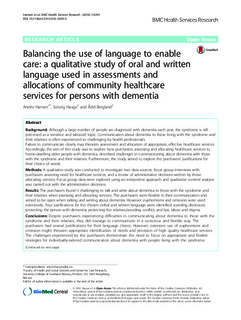| dc.contributor.author | Hansen, Anette | |
| dc.contributor.author | Hauge, Solveig | |
| dc.contributor.author | Bergland, Ådel | |
| dc.date.accessioned | 2017-12-13T10:24:23Z | |
| dc.date.available | 2017-12-13T10:24:23Z | |
| dc.date.created | 2016-08-24T09:25:21Z | |
| dc.date.issued | 2016 | |
| dc.identifier.citation | BMC Health Services Research. 2016, 16:391 (1), . | nb_NO |
| dc.identifier.issn | 1472-6963 | |
| dc.identifier.uri | http://hdl.handle.net/11250/2471086 | |
| dc.description.abstract | Background: Although a large number of people are diagnosed with dementia each year, the syndrome is still perceived as a sensitive and tabooed topic. Communication about dementia to those living with the syndrome and their relatives is often experienced as challenging by health professionals. Failure to communicate clearly may threaten assessment and allocation of appropriate, effective healthcare services. Accordingly, the aim of this study was to explore how purchasers, assessing and allocating healthcare services to home-dwelling older people with dementia, described challenges in communicating about dementia with those with the syndrome and their relatives. Furthermore, the study aimed to explore the purchasers’ justifications for their choice of words. Methods: A qualitative study was conducted to investigate two data sources: focus group interviews with purchasers assessing need for healthcare services, and a review of administrative decisions written by those allocating services. Focus group data were explored using an interpretive approach and qualitative content analysis was carried out with the administrative decisions. Results: The purchasers found it challenging to talk and write about dementia to those with the syndrome and their relatives when assessing and allocating services. The purchasers were flexible in their communication and aimed to be open when talking and writing about dementia. However, euphemisms and omission were used extensively. Four justifications for the chosen verbal and written language were identified: avoiding disclosure; protecting the person with dementia; protecting the relatives/avoiding conflict; and last, taboo and stigma. Conclusions: Despite purchasers experiencing difficulties in communicating about dementia to those with the syndrome and their relatives, they did manage to communicate in a conscious and flexible way. The purchasers had several justifications for their language choice. However, extensive use of euphemisms and omission might threaten appropriate identification of needs and provision of high quality healthcare services. The challenges experienced by the purchasers demonstrate the need to focus on appropriate and flexible strategies for individually-tailored communication about dementia with people living with the syndrome. | nb_NO |
| dc.language.iso | eng | nb_NO |
| dc.relation.uri | http://bmchealthservres.biomedcentral.com/articles/10.1186/s12913-016-1659-0 | |
| dc.rights | Attribution-NonCommercial-NoDerivatives 4.0 Internasjonal | * |
| dc.rights.uri | https://creativecommons.org/licenses/by-nc-nd/4.0/ | * |
| dc.subject | Demens | nb_NO |
| dc.subject | Kommunikasjon | nb_NO |
| dc.title | Balancing the use of language to enable care: a qualitative study of oral and written language used in assessments and allocations of community healthcare services for persons with dementia | nb_NO |
| dc.type | Journal article | nb_NO |
| dc.type | Peer reviewed | nb_NO |
| dc.description.version | publishedVersion | nb_NO |
| dc.source.pagenumber | 11 | nb_NO |
| dc.source.volume | 16:391 | nb_NO |
| dc.source.journal | BMC Health Services Research | nb_NO |
| dc.source.issue | 1 | nb_NO |
| dc.identifier.doi | 10.1186/s12913-016-1659-0 | |
| dc.identifier.cristin | 1375035 | |
| cristin.ispublished | true | |
| cristin.fulltext | original | |
| cristin.qualitycode | 2 | |

